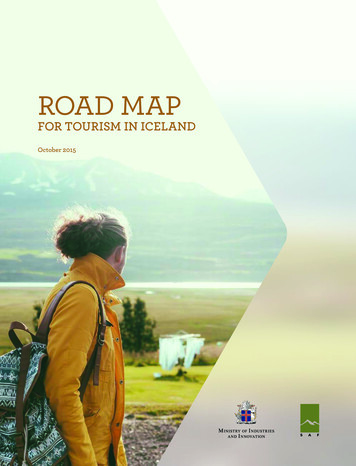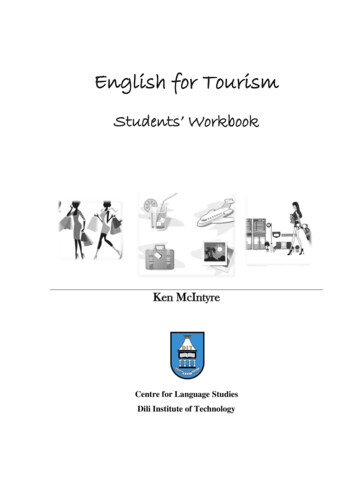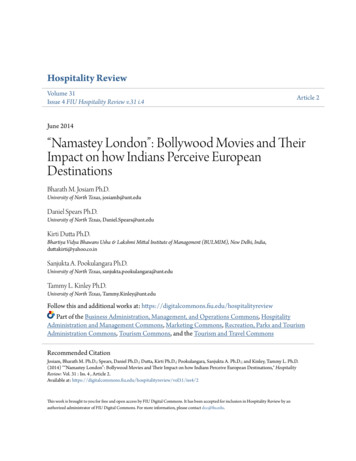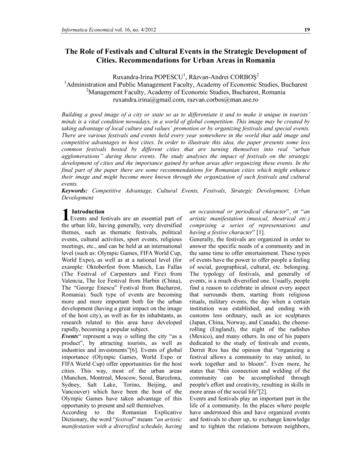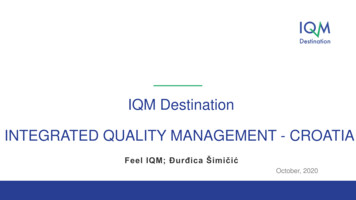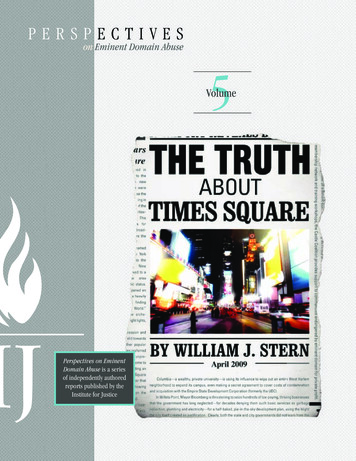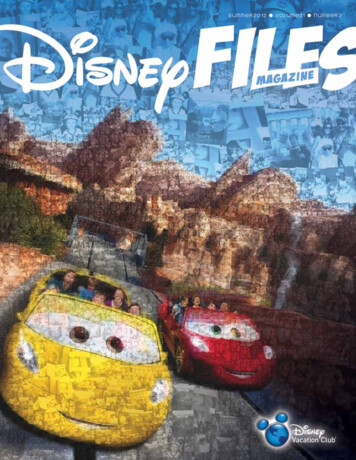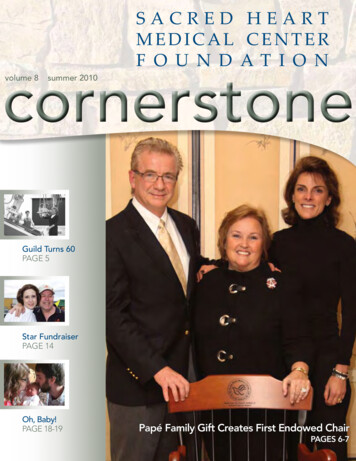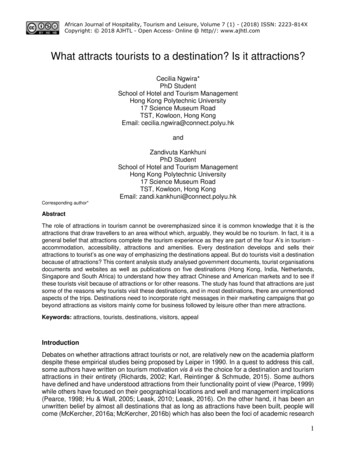
Transcription
African Journal of Hospitality, Tourism and Leisure, Volume 7 (1) - (2018) ISSN: 2223-814XCopyright: 2018 AJHTL - Open Access- Online @ http//: www.ajhtl.comWhat attracts tourists to a destination? Is it attractions?Cecilia Ngwira*PhD StudentSchool of Hotel and Tourism ManagementHong Kong Polytechnic University17 Science Museum RoadTST, Kowloon, Hong KongEmail: cecilia.ngwira@connect.polyu.hkandZandivuta KankhuniPhD StudentSchool of Hotel and Tourism ManagementHong Kong Polytechnic University17 Science Museum RoadTST, Kowloon, Hong KongEmail: zandi.kankhuni@connect.polyu.hkCorresponding author*AbstractThe role of attractions in tourism cannot be overemphasized since it is common knowledge that it is theattractions that draw travellers to an area without which, arguably, they would be no tourism. In fact, it is ageneral belief that attractions complete the tourism experience as they are part of the four A’s in tourism accommodation, accessibility, attractions and amenities. Every destination develops and sells theirattractions to tourist’s as one way of emphasizing the destinations appeal. But do tourists visit a destinationbecause of attractions? This content analysis study analysed government documents, tourist organisationsdocuments and websites as well as publications on five destinations (Hong Kong, India, Netherlands,Singapore and South Africa) to understand how they attract Chinese and American markets and to see ifthese tourists visit because of attractions or for other reasons. The study has found that attractions are justsome of the reasons why tourists visit these destinations, and in most destinations, there are unmentionedaspects of the trips. Destinations need to incorporate right messages in their marketing campaigns that gobeyond attractions as visitors mainly come for business followed by leisure other than mere attractions.Keywords: attractions, tourists, destinations, visitors, appealIntroductionDebates on whether attractions attract tourists or not, are relatively new on the academia platformdespite these empirical studies being proposed by Leiper in 1990. In a quest to address this call,some authors have written on tourism motivation vis ȃ vis the choice for a destination and tourismattractions in their entirety (Richards, 2002; Karl, Reintinger & Schmude, 2015). Some authorshave defined and have understood attractions from their functionality point of view (Pearce, 1999)while others have focused on their geographical locations and well and management implications(Pearce, 1998; Hu & Wall, 2005; Leask, 2010; Leask, 2016). On the other hand, it has been anunwritten belief by almost all destinations that as long as attractions have been built, people willcome (McKercher, 2016a; McKercher, 2016b) which has also been the foci of academic research1
African Journal of Hospitality, Tourism and Leisure, Volume 7 (1) - (2018) ISSN: 2223-814XCopyright: 2018 AJHTL - Open Access- Online @ http//: www.ajhtl.comof some authors (Lew, 1987; Leiper, 1990). From these papers, we see the importance of touristattractions in the tourism system or process but the drawback is that they have focused on thetraditional operationalization of the attractions. So what are tourist ‘attractions?’ Do they attracttourists? McKercher in 2016 fathered this debate in a quest to understand if an individual attractioncan indeed attract tourists into a destination.This paper will attempt to define what tourist attractions are, and how they are classified, and tryto link them to tourist motivation to visit attractions. At the centre of this work, we will analyse fivetourism destinations and two source markets to understand how these destinations perceive whattheir core attractions (tourism demand generators) are and relate them to the source markets tosee if tourists are attracted by the same attractions.Literature reviewTourist attractionsEarly works on attractions by Gunn (1972) affirmed that without attractions, there are no touristsor tourism. The converse is also true as ‘tourism attractions’ exist because of tourists and theyare ‘produced’ and marketed as such due to the availability of tourists (Lew, 1987). As Hu andWall (2005) put it, “tourist attractions are an essential ingredient for successful tourism destinationdevelopment” (p.617). Similarly, Benur and Bramwell (2015) assert that tourism destinations relyon their primary tourism products as mechanisms to pull and motivate tourists to visit them. Lew(1987) gives us a picture of what attractions are. He writes that attractions include all elementsthat draw tourists away from their homes and these include sightseeing, activities andexperiences. To set delimitations to this broad definition, Mac Cannell (1976) proposed that forany phenomenon to qualify to be an attraction, it needs to have three attributes which are; atourist, a site and an image or marker that popularizes the site. This distinction from MacCannelldoes not change anything in Gunn’s (1982) observations that tourists visit a destination becausethere is a tourist attraction which definitely has an image. However, from an ontological point ofview, Gunn’s sweeping statement does not take into consideration excursionists or domesticvisitors who can visit the attractions without necessarily sleeping over in that area. He assumesthat only tourists (overnight spenders) consume attractions.Harris and Howard (1996) proposed a different definition of attractions proposing that it (anattraction) could be a physical or cultural element of particular place with the capabilities ofsatisfying tourists’ specific leisure related needs. They encapsulate that these elements could beambiance in nature like climate, culture or specific to a location in cases of such things asmuseums or performances. This definition, just like Pearce (1991), has some flaws in itsconceptualization of what attractions are. For example, both do not consider other ‘elements’ suchas experiences that visitors seek in a destination, shopping, cuisine, sense of achievement,among others, as attractions. Besides, the definition assumes that tourists only travel for leisurepurposes eliminating other purposes of tourism trips such as business, visiting friends andrelatives, health among others. However, a more concise definition is provided by Hu and Wall(2005) who say that an attraction is a permanent resource that can either be natural or man-madeand whose main purpose of development and management is to attract tourists.From the definitions above, we can synthesize some meaning of attractions but for the purposesof this study, we will define an attraction from a tourist’s point of view as some phenomena,experiences, activities, sense of belonging or feeling offered at specific locations, at a cost or forfree that pulls or motivates tourists with a need to travel out of their usual environments to besatisfied and without which no trip would be made.2
African Journal of Hospitality, Tourism and Leisure, Volume 7 (1) - (2018) ISSN: 2223-814XCopyright: 2018 AJHTL - Open Access- Online @ http//: www.ajhtl.comClassification of tourist attractionsLew (1987) gives us one way of looking at tourist attractions. He says that attractions can beclassified from there distinct perspectives: Ideographic, Cognitive and Organizational. Lew (1987)purports that from an ideographic perspective, attractions are named and appreciated becauseof their own uniqueness which earns them a name. With this typology of naming or branding ofattractions, DMOs can decide how much entry fees to levy upon the attractions depending onhow it has been classified. Cognitive Perspective refers to the way people perceive an attractionto be either risky or not. In other words, the cognitive perspective of an attractions looks into howrisky tourism attractions can be and how prepared the tourists are to experience the attractionswith this perceived risk. This is linked to Plog (1990) psychographic study on tourist behaviour inchoosing destinations as well as modes of travel. His study concluded that some tourists displayallocentric behaviour because they choose new destinations on a continuous basis and arecurious about and they want to explore whereas on the other hand, psychocentrics are cautiousand less adventurous. Lastly, organizational perspectives focus on characteristics of attractionssuch as capacity, location, scale and whether they are permanent or not. Events such as Lake ofStars Festival in Malawi fit into this category as it is not permanent rather is hosted once everyyear.A more practical way of looking at attractions is provided by Lawton and Weaver (2010) whocapitalizing on Leask’s (2008) work, contend that attractions should not be classified based onownership, capacity, market, permanency and type only but for them to be comprehensiveenough and well encompassing, attractions should be classified according to such attributes asownership, orientation, spatial configuration, authenticity, scarcity, status, carrying capacity,accessibility, market and context (Lawton and Weaver, 2010) .Kotler and Keller (2012) and McKercher (2016a) present us a six tier product hierarchy which canalso be applied in the tourism system. According to these authors, every need could ably besatisfied by any product in the product family and its subsets depending on the simplicity orcomplexity of the need itself. In other words, specific needs can best be satisfied by specifictourism products. Similarly, attractions can also be classified as primary, secondary and tertiary.From this latter hierarchy, lesser attractions do not attract tourists other than competing theirexperience in the destination unlike primary attractions which are at the core of demandgeneration and have the ‘breadth’ and ‘depth’ of appeal (Mill & Morrison, 1985).Tourist attraction systemsGunn writing in 1988 said that a tourism system is a fusion of a tourist himself, attractions (nuclei)and markers which informs him about the destination or the attraction propelling him to visit. Sheproposes that the nuclei which could be a built attraction, a place or a cultural element, can belooked at from the perspective of motivation saying these nuclei motivate or stimulate people toleave their usual environments. Gunn (1998) adds that with the help of markers which are simplypieces of information found in the generating region, in transit and in the destination region(contiguous), a complete tourism system is created whence a tourist ha a complete tourism cyclefrom point A to point B, a proposition also supported by (Leiper, 1990).According to Mill and Morrison (1985), McIntosh, Goeldner and Ritchie (1990) writings on tourismattraction system theory, they posit that the more powerful an attraction is, the more its ability toattract tourists to that destination. Kotler and Keller (2002) and McKercher (2016a) present us asix tier product hierarchy which can also be applied in the tourism system. They say that everyneed could ably be satisfied by any product in the product family and its subsets, depending onthe simplicity or complexity of the need itself. In other words, specific needs can best be satisfiedby specific tourism products or attractions.3
African Journal of Hospitality, Tourism and Leisure, Volume 7 (1) - (2018) ISSN: 2223-814XCopyright: 2018 AJHTL - Open Access- Online @ http//: www.ajhtl.comThis is probably the founding stone of McKercher’s (2016b) attractions/needs relationshipframework which looks at the role of individual attractions in drawing tourists to a destination.According to McKercher (2016b), generic or multiple order tourists’ needs can be satisfied bysubstitutable activities which he also terms high order taxon consequently meaning that individualattractions has an insignificant or low role to play in attracting tourists to that destination. On theother hand, individual attractions have a high role to play in attracting tourists with singular/specificor low order taxon which has few substitutable. From this model, a DMOs can mark someattractions as lower order attractions and price them accordingly to target a specific tourist groupwith low order taxon of needs. As tricky as it is, McKercher warns DMOs against “wronglyassociating most popular places visited as reflecting the key motives why tourists visit” p.670. Inother words, the most visited attraction does not inherently transcend to the nuclei attraction orthe key reason why people visit that destination (McKercher, 2016b).MotivationThe whole essence of travelling is as a result of motivation- the trigger within and without anindividual to action. Crompton (1979) defined motivation as a driver or driving force that propelshumans to behave in a certain way. Supporting this line of thought, Oliver (2010) says that thisdriving force within human beings emanates because of two fundamental reasons; to get rid of aneed or to acquire or add some value to their lives. This mirrors Dann (1977) motivation theory ofanomie and ego enhancement (The Push and Pull factors). He proposed that tourists visit varioustourism destinations or attractions as a way of running away from their daily stress (anomie) orwith an aim of experiencing something new and achieve a sense of pride (ego- enhancement).Interestingly, authors content that in as much as tourists have needs that need to be satisfied, thedrive to buy a tourism product, in this case, an attraction, never arises unless the tourist inquestion is knowledgeable of such products that would get rid or satisfy of his need (Fodness,1994: Goossens, 2000). According to Hirschman and Holbrook (1982) in their hedonicconsumption study, tourists make fantasy imageries and emotions on the anticipated attractionor product which motivates them even more to buy it.Notwithstanding the fact that tourist motivation is a complex issue and there is no simple way ofunderstanding it, of importance to us in this essay is to understand if attractions do attract tourists.Dann (1981) posited that understanding the Pull factors in tourism helps destinations orattractions managers to discern why tourists come to their attractions for their ongoing or futuremarketing communication purposes. Fodness (1994) agrees with Dann (1981) saying that nodestination could run an effective marketing campaign if it fails to understand tourists’ motivations.These motivations could range from isolation to being with friends and family. In this viewtherefore, tourists have needs that need to be met while the destination has the means ofattributes that would satisfy those needs.All in all, authors agree that novelty seeking, social contact, escape, adventure, relaxation, natureand attraction are some of the motives for people to travel to destinations (Crompton,1979;IsoAhola & Allen, 1982; Goeldner & Ritchie, 2003; Pearce & Lee, 2005;Park & Yoon, 2009; Hsu,Cai & Li, 2010). Worth noting is the role that a destination image plays in motivating tourists tovisit. Destination image wraps up all forecasts, experiences and memories a tourist is to begotfrom a destination (Crompton, 1979; Hirschman & Holbrook,1982; Pike & Ryan, 2004) and has abearing on a tourists’ behavioural intentions in choosing a destination (Pike & Ryan, 2004; Baloglu& McCleary, 1999a). In a nutshell, we can agree that tourists travel to different destinations owingto their lifestyle bubbles in the generating region which either need to be reinforced or to beweakened.4
African Journal of Hospitality, Tourism and Leisure, Volume 7 (1) - (2018) ISSN: 2223-814XCopyright: 2018 AJHTL - Open Access- Online @ http//: www.ajhtl.comMethodologyThe authors reviewed secondary data from various academic journal articles, national destinationwebsites as well as books on attractions, motivations and tourism in general. International tourists’arrival information from five destinations tourism boards namely: Hong Kong, India, Netherlands,Singapore and South Africa as well as two source markets (USA and China) were reviewed.Domestic tourists were sieved out as their attraction needs are different from those of internationaltourists owing to the ‘usual environment’ and another reason was that incorporating domestictourists would have brought in some bias to the data.The data was looked at from McKercher’s (2016b) product taxonomy where singular or specificneeds are well met by low order taxon attractions that are rarely substitutable and their role inattracting tourists is very high while on the other hand, generic or multiple order tourist needs areeasily met by high order taxon attractions whose role in attracting tourists is very low. (See figure3.1 attached). Themes and patterns of tourists flows were identified from the data to inform us onwhy tourists come to the five destinations. Since we only used secondary data, it is possible thatsome core information was missed out which could shape the study into another direction andpossible future research.Research findingsWe considered and analysed five tourist destinations which are: Hong Kong, India, Netherlands,Singapore and South Africa. These countries were opted for because it was easier for us toaccess their tourism statistics online and their tourism statistics were ‘exhaustive’ enough ascompared to the other destinations. For comparisons sake, statistics from 2013-2017 were usedas they were the most recent in some of the chosen destinations. Considering that thesecountries are in different regions of the world, it was more applicable to only analyse two commonmarkets which are the United States of America and China unlike other markets which showed alot of disparities.According to ITB (2017), the American outbound travel market is the second biggest market bytrips at 60% after Germany and ranked first on expenditure in 2015. The main purpose of travelfor this American segment according to The USA Department of Commerce (2015) is holiday(51%) seconded by VFR travel at 27%. Moreover, 8% of these outbound international travellerswerve on their first trip abroad The Chinese market, on the other hand, is ranked fourth outboundmarket by trips and second on expenditure (ITB, 2017).Hong Kong DestinationAccording to the Hong Kong Tourist Board (HKTB,2017), the markets display different tastes forattraction consumption in the destination as well as their duration and expenditure characteristics.The Chinese MarketChina remains the most significant tourist market to Hong Kong as seen in its ever increasingtourist arrival numbers as well as tourist expenditure in the destination. According to the HongKong Tourist Board (2015), about 46 million Chinese tourists visited Hong Kong in 2015 with 60%of them being same day visitors. Of the 19,007 overnight visitors, 59% registered vacation as themain purpose of the visit followed by VFR at 22%. These were mainly people of the age rangesof 16-46 years who are termed as young (16-30 years) representing 28%, mid-career (31-45years) representing 24% and the Achievers (46 years ) representing 43% of the arrivals,respectively and who are a mirror of the market vacation segment target by the HKTB. Chinesetourist spent 14.1% less in 2015 at HK 142.3 billion but maintained position one with 73.9% oftotal tourist expenditure by the overnight category and had an average stay of 3.3 days.5
African Journal of Hospitality, Tourism and Leisure, Volume 7 (1) - (2018) ISSN: 2223-814XCopyright: 2018 AJHTL - Open Access- Online @ http//: www.ajhtl.comUSA marketWith tourist arrival numbers at 1,181,024 in 2015, USA was Hong Kong’s 4th market with a marketshare of 2% after China, Taiwan and South Korea but with an overnight visitor expenditure of HK 5.79 billion, USA is second to China on the expenditure scale. With more men than females visitHong Kong and with a mean age of 43.8 years, the main purpose of visiting was vacation at 46%followed by business at 27%. The average length of stay was 3.9 days and repeat visitors wereat 67%.The most visited attractions in Hong Kong2422191513THE VICTORIA PEAK AVENUE OF STARSDISNEYLANDLADIES MARKETOCEAN PARKFig 4.1 Hong Kong’s most visited tourist attractions in 2015Source: Hong Kong Tourist Board (2015)According to the Hong Kong Tourism Board statistics, 80% of the Chinese tourists had one singledestination, Hong Kong, while 20% visited other destinations on their trip. For the long haul market(USA Inclusive), 17% came specifically for Hong Kong while 83% had multiple destinations suchas China (35%), Macau (24%) and Thailand 12% among other destinations (Hong Kong VisitorProfile, 2016). Interesting to note is the fact that most visitors to Hong Kong from China, wererepeat visitors with figures pegged at 80% with an average stay of 3.2 nights.Table. 4.1 Tourists activities in Hong KongCountry/RegionChinaShort HaulLong HaulShoppingDining & SightseeingTheme Park88%78%57%39%68%69%27%30%11%Destination IndiaTourism in India is reportedly growing at the rate of 13% per annum compared to 7% growth ratein the world (Chavan & Bhola, 2014) and international tourism has also followed this trend withtourists coming from the US, UK, Middle East, South Africa, Spain, France and others. Despitetourism being largely unplanned in most states, Kerala, Goa, Jammu, Kashmir and HimachalPradesh had tourism incorporated into their state plans (Chavan & Bhola, 2014).6
African Journal of Hospitality, Tourism and Leisure, Volume 7 (1) - (2018) ISSN: 2223-814XCopyright: 2018 AJHTL - Open Access- Online @ http//: www.ajhtl.comUSA MarketAccording to the Government of India (2016), American tourists to India ranked on position oneon the international tourists’ arrivals with 1,213,624 tourists representing 15.12% of theinternational arrivals in India and they mainly visited in December. India received more maletourists from USA than females at 59.3%. Of these tourists, 20.4 % were between the age rangeof 45-54 years followed by an age range of 0-14 years at 20%, who probably accompanied theirparents or guardians.Chinese MarketChina is India’s 11th international source market with 206,322 tourists recorded in 2015. Of thesetourists to India, 63.8 % were males and the most prevalent age range was 25-24 years at 40%followed by the age range of 35-34 at 25.8%. Of these visits to India, 11.2% were recorded inNovember as compared to 6.3% in May.India’s Top five visited Attractions (2015)600 000500 000400 000300 000200 000100 0000Taj MahalAgra FortQutab MinarFatehpurSikriRed FortFigure 4.2 The five most visited attractionsSource: India Tourism Statistics data (2016)7
African Journal of Hospitality, Tourism and Leisure, Volume 7 (1) - (2018) ISSN: 2223-814XCopyright: 2018 AJHTL - Open Access- Online @ http//: www.ajhtl.comThe Figure below illustrates the most visited five states according to the Government of India(2016).5 000 00025%4 500 0004 000 00020%3 500 0003 000 00015%2 500 0002 000 00010%1 500 0001 000 0005%500 00000%Tamil NaduMahashtraUttar PradeshDelhiWest BengalFigure 4.3: Tourist visit to some Indian StatesDestination NetherlandsDestination Netherlands enjoys vibrant domestic tourism as well as international tourism asevidenced by the number of international tourists who visited in 2016. There were a total of 15.5million international tourists who were mostly from neighbouring countries (Netherlands Board ofTourism and Conventions [NBTC], 2016a). According to NBTC Statistics Incoming Tourism(2014), most international tourists (69%) visit Holland for short holidays and they are categorizedas leisure tourists.The majority of these tourists, plan their trips in advance and mostly use the internet beforebooking. Leisure travellers top this list at 87% and they mainly booked their travel less than amonth before setting off. At least 52% of all international visitors to Holland were repeat visitorsin 2014, (NBTC, 2014) and most first time visitors were observed from long- haul markets suchas Russia, Brazil, Spain and China at 74%, 69% and 54% respectively.Chinese MarketThe Chinese market in Holland prefers guided tours owing to the immature nature of the big partof it but more and more young travellers go solo and engage in shopping on the trip (NBTC,2016b). The Chinese market perceive Netherlands as a land of tulips, windmills and clogs suchthat most of the visitors come to Holland for these attractions. Of the 330,000 Chinese visitors toNetherlands in 2015, 55% had a business motive in Amsterdam and the average length of staywas 5.1 nights on which they spent about 1,256.Most Chinese tourists in Holland engage in Walk through the city (14%), walking (12%), funshopping (11%) and visiting a café or bar (8%). According to the HBTC (2015), most Chinesevisitors to Holland come on multi- destination tours which take them to two or three destinations.The main purpose of visiting Holland according to NBTC (2014) is rest, relaxation and fun akinScandinavians, Germans and Belgians.8
African Journal of Hospitality, Tourism and Leisure, Volume 7 (1) - (2018) ISSN: 2223-814XCopyright: 2018 AJHTL - Open Access- Online @ http//: www.ajhtl.comThe USA marketThe US market is ranked 4th international source market in Holland with slightly over 1 millionvisits and 59% of them having a holiday motivation in Amsterdam. With an average stay of 4nights, most Americans visit Holland in spring and summer which spans from April to September.According to NBTC Statistics Incoming Tourism (2014), Americans engaged in activities likewalking through the city (22%), visiting notable/historical places or building (12%) and visiting amuseum (11%) and walking (9%). America is considered as the main source continent of longhaul market with these statistics and it ranked 4th again on international leisure visitors to Holland(NBTC, 2014).Destination SingaporeThis city country has more attributes similar to it sister city Hong Kong and having roots with theChinese decent, Singapore Tourism Board (STB, 2016) observes that it makes it difficult forSingapore to competitively attract tourists who seek deep and authentic Asian experience.USA MarketUSA was Singapore’s 11th international market as most Americans prefer China and India as theirAsian destinations owing to ‘their authentic and distinctive cultures and architecture’ (STB, 2016)statistics. USA’s outbound tourists to Asia predominantly travel for VFR (45%) followed byholidaying (27%) and a majority of them travel in December. However, in 2014 American touristsvisited Singapore for various reasons such as; holidays at 47% followed by business/MICE at27% (75% being repeat visitors) and lastly 10% stopovers. STB (2016) notes that Americantraveller’s despite being cultural explorers, consider authentic cultures, good hygiene factorshighly when choosing a destination.According to STB (2016) statistics, the USA market perceives Singapore as more westernizedthan other Asian destinations although very expensive and hence 86% leisure seeking Americanswere in Singapore as part of their multi-destination trip and consider Singapore as a stopover orsecondary destination (Mill & Morrison, 1985). Despite the general feeling among Americans thatSingapore lacks differentiation and vibrancy and cultural distinction from other South East Asiandestinations, Americans showed their quest for ‘authentic cultural experiences’ by visiting;Chinatown, Gardens by the Bay, Little India, Marina Bay Sands and Sands SkyPark (STB,2016).Chinese MarketThe Chinese market with 2.864 million tourists was the second largest inbound market intoSingapore after Indonesia but the Chinese market beats Indonesia and any other market onexpenditure with most Chinese engaging in shopping of fashion accessories, genuine jewellery,clocks and watches (STB,2014). But according to the recent STB report on Tourism PerformanceReport in first quarter of 2017, China was ranked first displacing Indonesia and maintained itsleadership on tourism expenditure.Given the Chinese gifting culture, as well as status need to own foreign brands, it is unsurprisingthat they spend more on shopping than any other item. Contrariwise, the Chinese market spendsless on accommodation than the average visitor to Singapore as they prefer budget hotels. STB(2014) observes high tourist numbers from China during summer school holidays (June- August)and little in flows during the Spring and National Day holidays. This reflects why most Chinesetourists to Singapore are family travellers and early career types.According to the STB (2014), beginner travellers prefer multi-destination packaged tours with predetermined itineraries while the mature and experience travellers prefer independent travel which9
African Journal of Hospitality, Tourism and Leisure, Volume 7 (1) - (2018) ISSN: 2223-814XCopyright: 2018 AJHTL - Open Access- Online @ http//: www.ajhtl.comgives them flexibility and freedom to venture in their favourite activities while on the trip. Whilenovice travellers prefer visiting iconic well known attractions such as SkyPark, Singapore Flyer,Marina Bay Sands and Universal Studios whereas the mature tourists demand “deeperexperiences and engagement with cultures and heritage of the local people” STB (2014).Perceived as a safe, modern and clean destination, most Chinese tourists to Singapore admire itas a Garden City suitable for family vacations, with similar cultures and food being an addedadvantage. Overall, Chinese travellers seek discovery, enlightenment and a sense ofaccomplishment followed by keeping up with friends when they travel and they plan and booktheir travel 8-30 days in advance (STB, 2014).Destination South AfricaJust as in the case of the foregoing destinations, South Africa emphasizes attractions on theadverts sent out to the public. South Africa is marketed as a ‘diverse and enchanting country’ inthe world and attractions such as Kruger National Park, heritage sites such as Robben Island,Cape Town the home of beach life and Table Mount
ambiance in nature like climate, culture or specific to a location in cases of such things as museums or performances. This definition, just like Pearce (1991), has some flaws in its conceptualization of what attractions are. For example, both do not consider other ‘elements’ such as expe
